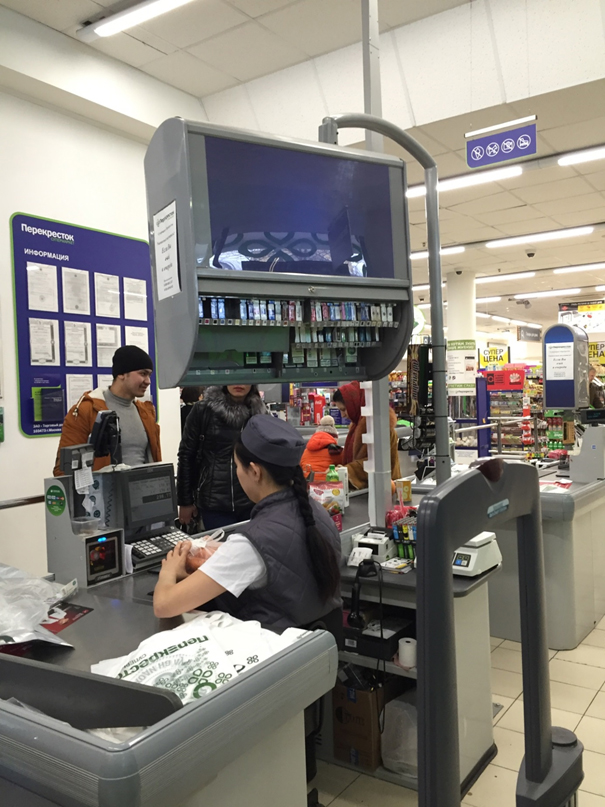Current Tobacco Use:
Adults
Youth
Population:
144.0 million
Adult Tobacco Users:
36.4 million
Annual Deaths Caused by Tobacco:
309,500
Monitor tobacco use and prevention policies
Data are necessary to implement and evaluate effective tobacco control policies. The Global Adult Tobacco Survey (GATS) is a global standard for systematically monitoring adult tobacco use (smoking and smokeless) and tracking key tobacco control indicators.
In the Russian Federation, the Information and Publishing Center “Statistics of Russia” under the Federal State Statistics Service (Rosstat) and the Research Pulmonology Institute under the coordination of the Ministry of Health of the Russian Federation conducted GATS Round 1 in 2009 and GATS Round 2 in 2016.
Adults who use tobacco decreased
GATS Russian Federation 2009 and 2016
*Comparisons are significant at p<.05; Difference is larger than can be reasonably explained by chance and therefore reflects a true difference.
Note: Tobacco users include both smoked and smokeless tobacco users. Smokeless tobacco users account for <1% of adult tobacco users in the country.
Note: Estimates presented were produced for comparison estimates between 2009 and 2016. The estimates might be different from the estimates produced using the full sample of GATS 2016 data.
Protect people from tobacco smoke
There is no safe level of exposure to secondhand smoke. The sole intervention that can fully protect people from the health dangers of secondhand smoke is creating environments that are completely smoke-free without any exceptions.
100% Smoke-Free Russia
As part of the comprehensive tobacco control laws, on 1 June 2013, the Russian Federation implemented 100 percent smoke-free policies in educational, medical, cultural and sport facilities; all government buildings; elevators and stairwells of apartment buildings; public transportation; airports; and all public playgrounds and beaches. One year later, smoke-free zones were extended to the other forms of public transportation, hospitality venues – including hotels, cafes, bars and restaurants – and shopping areas.
To disseminate the message of smoke-free zones in bars and restaurants, various Russian regions launched a campaign about the harms of secondhand smoke.
Offer help to quit tobacco use
When informed of the risks, most tobacco users want to quit, but few get help and support to overcome their dependence. There are several evidence-based supports that can increase the chance to quit successfully.
Text Message Service to Help Smokers Quit
The Health and Development Foundation in cooperation with the Ministry of Health launched a project, BrosayemKurit.rf; to help current smokers quit. The project includes a free text message service that provides psychological and information support, a mobile app, webinars and a website.

Adult smokers advised to quit by a health care provider increased
GATS Russian Federation 2009 and 2016
*Comparisons are significant at p<.05; Difference is larger than can be reasonably explained by chance and therefore reflects a true difference.
Note: Estimates presented were produced for comparison estimates between 2009 and 2016. The estimates might be different from the estimates produced using the full sample of GATS 2016 data.
Warn about the dangers of tobacco
Effective health warning labels provide health messages directly to tobacco users, which raises awareness of their health risks and increase the likelihood that they will reduce tobacco use or quit altogether.
Health Warning Labels on Tobacco Products
The Russian Federation adopted stricter regulations on tobacco product packaging and labeling and as of 15 November 2017, pictorial health warning labels are required on 50 percent of 2 principal display areas.
Adult smokers who thought about quitting because of health warning labels increased
GATS Russian Federation 2009 and 2016
*Comparisons are significant at p<.05; Difference is larger than can be reasonably explained by chance and therefore reflects a true difference.
Note: Estimates presented were produced for comparison estimates between 2009 and 2016. The estimates might be different from the estimates produced using the full sample of GATS 2016 data.
Enforce bans on tobacco advertising, promotion and sponsorship
Tobacco advertising, promotion and sponsorship (TAPS) increase tobacco use. Comprehensive TAPS bans have shown to reduce tobacco consumption.
Tobacco Products Banned
On 1 July 2013, the Russian Federation’s comprehensive tobacco control laws included a ban on sales of tobacco in all educational, medical, cultural and sports facilities; in rail stations, airports and other transportation hubs; and within 100 meters of educational institutions.
Additionally, the most recent comprehensive tobacco control law (2013) requires a point-of-sale ban that requires all tobacco products be hidden from plain view in stores (see picture).

Raise taxes on tobacco
The most effective way to reduce tobacco use and encourage tobacco users to quit is to raise taxes to increase the price of tobacco products.
Tobacco Tax Increases Annually
Since 2010, the Russian Federation has raised tobacco taxes annually using a mixed excise tax system that includes both a specific tax component and an ad valorem tax component. The average excise tax has increased by at least 30 percent each year.
Average cost of pack of cigarettes increased
Note: Estimates presented were produced for comparison estimates between 2009 and 2016. The estimates might be different from the estimates produced using the full sample of GATS 2016 data.



